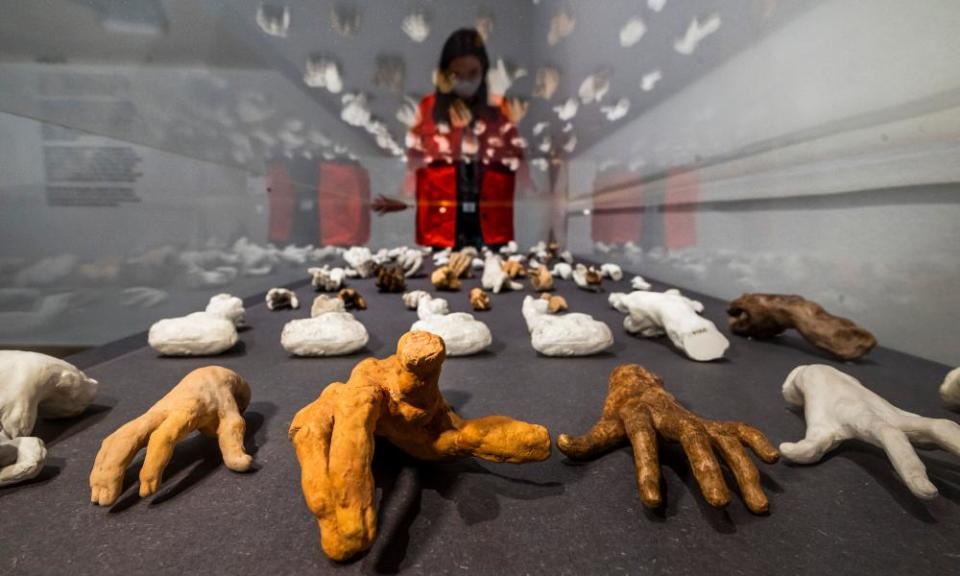Achim Borchardt-Hume obituary
Tate Modern curator who introduced exciting contemporary artists to the public and illuminated the work of key historical figures
Visitors to Tate Modern have been captivated in equal measure by Anicka Yi’s translucent squid-like “aerobe” machines, floating through the cavernous Turbine Hall, and Rodin’s exquisite plaster casts of arms, legs and bodies exhibited in the galleries upstairs.
The curator Achim Borchardt-Hume, who has died aged 56, worked on both these recent projects in his role as Tate Modern’s director of exhibitions and programmes, demonstrating his scope in organising exhibitions that both introduced exciting contemporary artists to the general public, and illuminated the life and work of key historical figures.
Achim was driven by the notion that through exhibitions it should be possible to get closer to the subject “as a living breathing artist, [a] human being. With everything that that means … ambition, doubts, happiness, sadness.” The Rodin exhibition was emblematic of this experiential approach: rather than present the sculptor’s greatest hits, he chose the medium of plaster to give us a route into an artist whose work we thought we knew.
A scholar of art history as well as a museum professional, Achim presented ambitious exhibitions (in particular re-interpreting the modernist greats) that were always focused on a wish to tell a clearly presented story to the widest possible audience. Picasso 1932: Love, Fame, Tragedy, co-curated by Nancy Ireson in 2018, took the radical yet simple idea of exploring a single watershed year, when Picasso had turned 50 and produced an extraordinary number of key paintings. The exhibition’s concise, month-by-month narrative, combined with rich archive material, created an experience that was arguably Achim’s greatest critical success. It also drew in more than 520,000 people, making it Tate’s second most visited exhibition.
Achim was born in Düren, Germany, to Günter Borchardt and Anna Maria Struck. After finishing an exchange scholarship at the Università La Sapienza, Rome, in 1990 he took an MA in art history, Italian literature, psychology and Christian archaeology at Bonn University. In 1992 he moved to the UK to undertake a PhD at the University of Essex, his thesis focusing on the art and politics of fascist Italy.

Achim began his career in the public arts sector as an exhibition organiser at the Serpentine Gallery, in London (1999-2005). After a brief period at the Barbican art gallery, he joined Tate as a curator of modern and contemporary art in 2005, and over the following four years would curate several large-scale exhibitions at Tate Modern, including most notably Albers and Moholy-Nagy (2006) and Rothko: The Late Series (2008), as well as Doris Salcedo’s technically challenging installation, Shibboleth (2007), which required specialist engineering to construct a 167-metre-long crack in the floor of the Turbine Hall.
The Rothko exhibition, the first in the UK dedicated to the artist’s late abstract paintings, aimed to capture, as Achim described it, “the extraordinary existential endeavour” that underpinned Rothko’s art. The highlight was the bringing together for the first time since their inception 16 Seagram murals, nine from Tate’s collection with those loaned from the US and Japan, seen alongside Rothko’s last series, Black on Grey, finished in the final year of his life.
In 2009 Achim moved to the Whitechapel Gallery as chief curator, where exhibitions included those of artists Walid Raad (2010), Wilhelm Sasnal (2011), Thomas Struth (2011) and Zarina Bhimji (2012).
Achim returned to Tate Modern in 2012 as head of exhibitions, becoming its director of exhibitions and programmes in 2017, working with the director, Frances Morris, to further shape the museum’s future, particularly as it grew in size and ambition with the opening of its extension in 2016.
Malevich (co-curated by Iria Candela, 2014), introduced new research on the artist’s confrontation with the Stalinist regime as well as revealing the extent of his influence on contemporary artists, while the comprehensive survey of Robert Rauschenberg (co-curated by Catherine Wood, 2016) told the story of how the artist’s passion for collaboration encompassed not only painting and printmaking but also technology, stage design and performance.

His belief in collective endeavour, empathy and sensitivity towards artists – both historical and contemporary – were his trademarks.
Behind the scenes, he supported artists working on their own exhibitions, such as Olafur Eliasson, Steve McQueen and Lubaina Himid, shaped the experimental performance art programme BMW Tate Live, chaired the steering group for the Hyundai Tate Research Centre: Transnational, which explores interconnected global art histories, and was director champion of the staff BAME Network.
Beyond Tate he was a regular conference panelist and speaker, and a trustee of several organisations, including the independent community arts organisation PEER, in east London.
As I experienced when working with Achim at Tate, he liked to challenge art orthodoxy. With charm and wit, spoken in his Rhineland-German inflected accent, he always enjoyed persuading you to see a different point of view.
Achim is survived by his wife, Laura Hume, whom he married in 1995, their children, Saskia, Tom and Matti, and his sisters, Claudia and Rita.
• Achim Borchardt-Hume, curator, born 25 September 1965; died 1 November 2021

 Yahoo News
Yahoo News 
